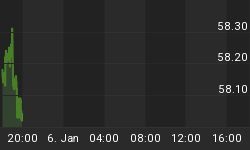Last week was a busy time for central banks. In particular, the European Central Bank released its most recent monetary policy statement. What does it imply for the gold market?
Riksbank Keeps Rates Steady, but Expands QE
On Thursday, three major central banks announced their interest rate decisions. First, Sweden's Riksbank left its repo rate unchanged at 0.5 percent, but it extended its quantitative easing program for another six months, citing uncertainty over economic and political developments abroad. The Risksbank wrote in its statement:
"Growth around the world is increasing in line with the Riksbank's earlier forecasts. The global economy is in a phase with increasingly strong industrial activity and rising global trade. However, considerable political uncertainty is prevailing in several parts of the world, creating risks for economic developments."
Bank of Japan Stands Pat on Monetary Policy, but Changes its Economic Outlook
The BoJ also held policy steady as widely expected. However, it raised its GDP growth forecast for the 2017-2018 fiscal year from 1.5 percent to 1.6 percent. At the same time, the BoJ lowered its core consumer price index growth forecast from 1.5 percent to 1.4 percent. It signals that the end of ultra loose monetary policy will not happen quickly in Japan. The BoJ will continue its quantitative easing program and yield curve control to "achieve the price stability target of 2 percent, as long as it is necessary for maintaining that target in a stable manner". Hence, the divergence between the monetary policies of the Fed and the BoJ is likely to stay with us, which should support the U.S. dollar. This is obviously bad news for gold, which is negatively correlated with the greenback.
All Quiet on the European Front
The European Central Bank kept its key interest rates and asset purchase program unchanged. However, the economic situation in the Eurozone improved, while the risks softened. In his opening statement, Mario Draghi said:
"Incoming data since our meeting in early March confirm that the cyclical recovery of the euro area economy is becoming increasingly solid and that downside risks have further diminished."
However, inflation continued to undershoot the ECB's target, so the dovish stance is still warranted, according to Draghi:
"Underlying inflation pressures continue to remain subdued and have yet to show a convincing upward trend. Moreover, the ongoing volatility in headline inflation underlines the need to look through transient developments in HICP inflation, which have no implication for the medium-term outlook for price stability. A very substantial degree of monetary accommodation is still needed for underlying inflation pressures to build up and support headline inflation in the medium term."
Nevertheless, Draghi sounded rather optimistic at the press conference. He said that the risks surrounding the euro area growth outlook had moved towards a more balanced configuration, while "the risks of deflation have virtually disappeared". Although there was not any movement from the ECB, markets expect hawkish changes in the forward guidance as early as in June. If the ECB adopts a more hawkish change, the euro should appreciate against the U.S. dollar, which could be positive for the gold market.
Conclusions
A few major central banks announced their statements on monetary policy on Thursday. In particular, both the ECB and the BoJ kept their key interest rates and quantitative easing programs unchanged. Hence, the divergence in monetary policies between the Fed and other major central banks remains in place, which provides support for the yellow metal. The BoJ is unlikely to change its dovish stance in the near future, but the ECB may adopt more hawkish forward guidance as early as in June. We do not expect a revolution, but such a change could weaken the U.S. dollar, at the margin, while supporting the price of gold.
Thank you.
Disclaimer: Please note that the aim of the above analysis is to discuss the likely long-term impact of the featured phenomenon on the price of gold and this analysis does not indicate (nor does it aim to do so) whether gold is likely to move higher or lower in the short- or medium term. In order to determine the latter, many additional factors need to be considered (i.e. sentiment, chart patterns, cycles, indicators, ratios, self-similar patterns and more) and we are taking them into account (and discussing the short- and medium-term outlook) in our trading alerts.















